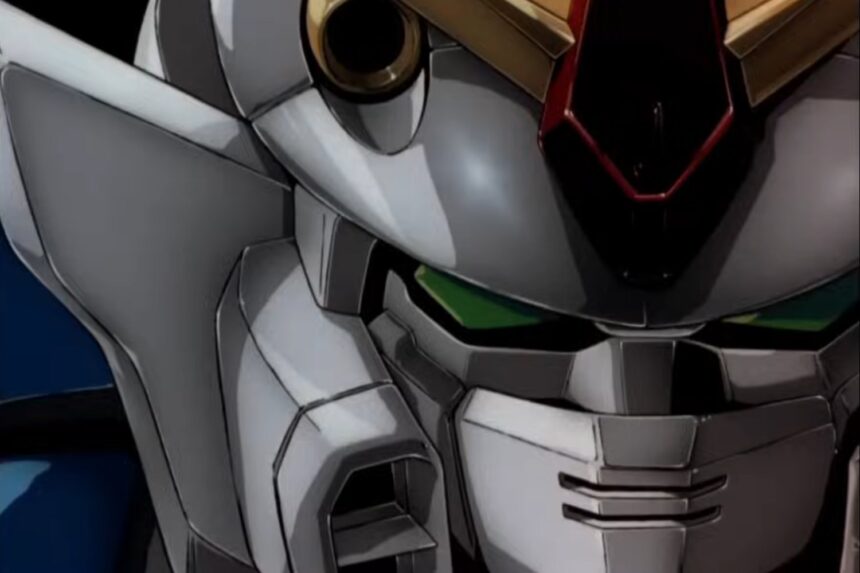Thirty years ago in Japan today, Heero Yuy infamously tore up the birthday invite of Relena Peacecraft and threatened to kill her—and it was more than just meme history that was forever changed. It would take just shy of another five years for it to happen, but Gundam had laid the groundwork for its first major hit outside of Japan—and bring its big robots, and even bigger ideas, to a whole new audience.
Released in Japan on April 7, 1995—to celebrate the Gundam franchise’s 16th anniversary on the same day—Gundam Wing was the franchise’s second dip into the world of alternate timelines beyond the series’ iconic primary continuity, the Universal Century. Its predecessor, Mobile Fighter G Gundam, had juked where, up to that point, Gundam had jived, trading broad astropolitical worldbuilding for more shonen and super robot influences. Wing then, would return to jiving, establishing a precedent that practically every alternate universe series has followed since: new characters, new setting, but themes and stories that would resonate with, and be in conversation to, ideas first established in those Universal Century stories.
Set in the year After Colony 195, Wing establishes a familiar Gundam scenario: humanity has advanced into the stars and to a series of space colonies within the solar system, but dissent between the latter wishing for independent rule away from the former has sparked a period of violent tensions. Unlike the Universal Century, the colonies are the protagonists and heroic perspective here, with a group of scientists working together to build five Gundams, powerful mobile suits, and send them to Earth alongside young, specially trained pilots, originally unaware of each other, but dedicated to their mission of liberating the colonies from the yoke of Earth’s militarism at any cost.
If G Gundam had extrapolated the franchise to one of its most heightened potentialities, then Wing was intrigued with the more rooted aspects of what had made Gundam in the first place, a story about youth and war, about the politics of peace—and perhaps even further rooted than that, largely eschewing fantastical ideas like the psionics of Newtypism to depict a more grounded reality, but of course one where giant robots shot the ever-loving hell out of each other. Wing instead found its fantasy in the high melodrama of its interpersonal relationships, giving the five members of the Gundam Team—Heero, Quatre, Trowa, Wu Fei, and Duo a feisty, fractured relationships that created plenty of drama (and, inevitably in the vein of fujoshi interest before it with Char and Amuro, plenty of material for a thriving fan shippers—there’s a reason why perhaps Wing more than most Gundam shows has swathes of promotional artwork depicting the cast in slice of life scenarios or in boy bands).
But in Japan, beyond that layer of interest in the five boys themselves, Gundam Wing was only a marginal success. What made Wing important wouldn’t happen for another five years, when it became the first Gundam series to air on Toonami—introducing Western audiences not just to its own vision of what Gundam was, but for many, what the franchise was altogether. Riding a wave of anime interest that had exploded with the likes of Pokémon and Dragon Ball before it, Gundam Wing‘s arrival in 2000 was another landmark in entrenching the medium’s popularity in the West. Without its adaptation, Gundam‘s place outside of Japan would be very different—fundamentally changing a relationship that has developed over the past 25 years, to where now Gundam movies hit theaters around the world, and the latest shows in the franchise air day and date.
It’s perhaps fitting then, that Wing‘s 30th anniversary falls on the eve of a new era for Gundam. GQuuuuuuX, the latest show in the franchise—itself straddling the line of alternate-universe storytelling and direct links to the Universal Century in fascinating ways—is set to begin this week, a new generation that will be experienced by Gundam fans around the world. Access to the broader world of Gundam in the years since may take off some of Wing‘s nostalgic sheen; it’s a show that becomes increasingly thematically muddled as it goes on, and its best ideas are explored in more interesting ways elsewhere in the franchise. But even then, it’s still difficult to imagine a better series to have introduced the world to Gundam at large than it, timed at a perfect moment to enthrall a generation of nascent anime fans—a gateway that showed you that giant robots were extremely cool, but that the ideas behind them could be even cooler.
Gundam Wing is streaming on Crunchyroll, for any and all, but especially those nostalgic now-30-somethings with a fondness for Just Communication.
Want more io9 news? Check out when to expect the latest Marvel, Star Wars, and Star Trek releases, what’s next for the DC Universe on film and TV, and everything you need to know about the future of Doctor Who.
Read the full article here











